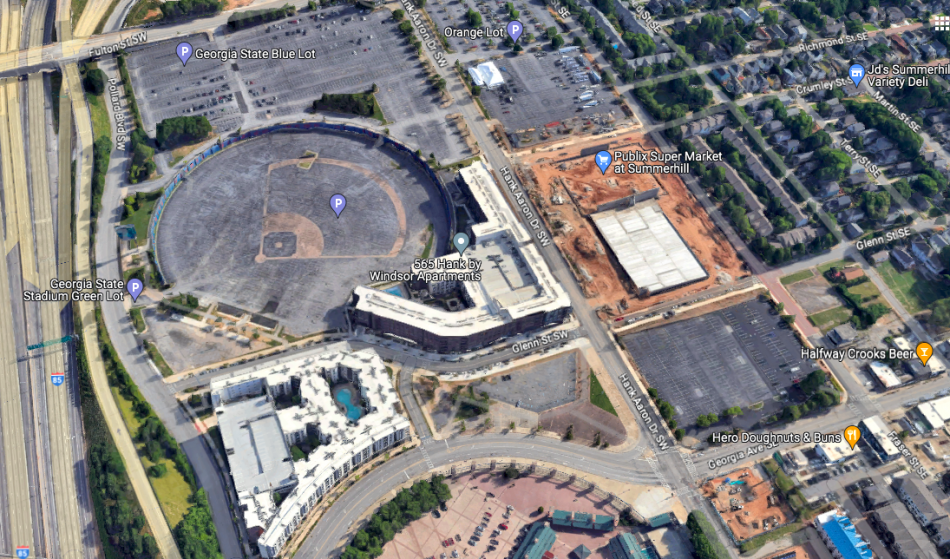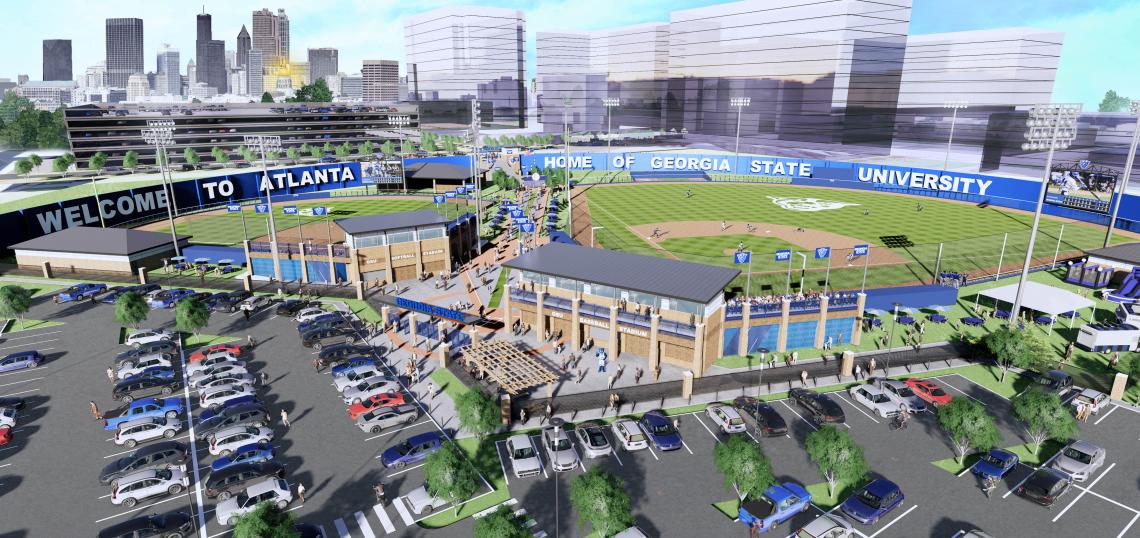With summer in full swing, so to speak, and the Atlanta Braves on a historic hot streak, it seems an opportune time to wonder aloud: What’s up with plans for converting the old Atlanta-Fulton County Stadium site into a new Georgia State University baseball and softball complex?
As anyone with a passing interest in Atlanta development knows, the presence of GSU athletic facilities and its nearby campus has been a catalyst for Summerhill’s mixed-use transformation around Georgia Avenue since the Braves decamped to Cobb County.
But what about the diamond-shaped parking lot area behind so many new apartments, where Hank Aaron etched himself into immortality nearly 50 years ago? What happened to plans for the antithesis of paving paradise—and bringing baseball (alongside softball) back to Summerhill?
For answers, we turned to Dane Hawthorne, sports design leader at SLAM architecture’s Atlanta office (alternately, The S/L/A/M Collaborative), whose firm has been involved with planning Summerhill’s next act near the former Turner Field for the better part of a decade. Answers in the following Q&A have been lightly modified for clarity and length.
Urbanize Atlanta: Could you describe the site conditions today? Is the adjective “historic” appropriate for this parking lot?
Dane Hawthorne: “Historic” is absolutely appropriate, because this is the site of Hank Aaron breaking Babe Ruth’s all-time home run record, one of the most iconic moments in American sports history. [It was] an event of huge cultural significance with a Black man breaking this home run record and being cheered on by white baseball fans in the deep South in 1974. This event needs a better monument, and nothing could be a better backdrop than a ballpark once again.
 The GSU stadium site's context prior to Summerhill's new Publix opening across the street. Google Maps
The GSU stadium site's context prior to Summerhill's new Publix opening across the street. Google Maps
UA: How would redevelopment plans preserve Hank Aaron’s legacy here?
DH: They would put the home plate at the stadium entry plaza, the home run fence in a plaza adjacent to the outfield, with the home run path forming a concourse that fans could experience firsthand.
Hank Aaron’s statue is the only one that the Braves didn't take to Truist Park. The statue shows Hank Aaron mid-swing of that historic home run. It sits outside what is now Center Parc Stadium, waiting to be moved across the street to the perfect spot at the actual spot the home run was hit. What better Instagram moment could there be?
 North view over the stadium complex toward downtown, as shown with tentative designs that include a softball field next door. Courtesy of SLAM architecture
North view over the stadium complex toward downtown, as shown with tentative designs that include a softball field next door. Courtesy of SLAM architecture
UA: It’s been several years since the baseball stadium concept first emerged. How have plans and designs evolved since then, if they have?
DH: We initially showed the ballpark in the exact location of the Atlanta-Fulton County Stadium field so that the wall would be incorporated into the actual new outfield wall of the new ballpark.
In further iterations, we shifted the ballpark to the east to maximize the rest of the site for other uses. This shifted the home run path out of the actual field of play onto a concourse where the statue could sit and fans could interact, which we realized was a better solution as well.
 The most recent concept available for GSU's project, which will be located just north of the former Turner Field, now GSU football's Center Parc Credit Union Stadium. Courtesy of SLAM architecture
The most recent concept available for GSU's project, which will be located just north of the former Turner Field, now GSU football's Center Parc Credit Union Stadium. Courtesy of SLAM architecture
UA: What specifically is SLAM's role in this project, and who else is involved, beyond GSU?
DH: We first master-planned the site as part of our athletic master-planning work for the university and [developer] Carter in their bid to purchase the property from the city in 2016. We planned the football stadium, this baseball stadium, and a parking deck as a part of that effort that ultimately proved the viability of converting Turner Field to [GSU’s] football stadium.
We have since provided renderings to assist the university with planning and fundraising for the project. In 2022, we were engaged by the university to do a preliminary site design in order to address extensive soil remediation that needs to be addressed on the site.
UA: What exactly does the baseball stadium concept call for, in terms of seating capacity, field length, amenities, etc.? Any specific plans for shade, too?
DH: Plans call for roughly 1,000 seats with associated restrooms and concessions. Field length and other details have not been finalized.
UA: Has a specific name been selected?
DH: No.
UA: And the million-dollar question... What’s the latest on when this project might break ground? And any ETA on opening the parks?
DH: Not at this time. Remediation solutions and parking offsets are being figured out at this time.
...
Follow us on social media:
• Summerhill news, discussion (Urbanize Atlanta)






